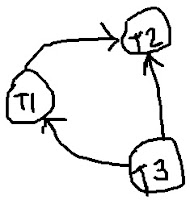The ISRO Computer Science (CS) Scientist Engineer test held on April 16, 2011 (Saturday). Total questions were 80 and test duration were 90 Minutes. Here is the solution of paper according to me of set A.
- The Answer Key 2011 for Set A Non-Official by Me: Click here (By ISRO not available)
- For complete preparation for ISRO Computer Science visit my this article: Click Here
- For ISRO Answer Key and Solutions Computer Science Scientist Engineer 2016: Click here
- For ISRO Answer Key and Solutions Computer Science Scientist Engineer 2015: Click here
- For ISRO Answer Key and Solutions Computer Science Scientist Engineer 2014: Click here
- For ISRO Answer Key and Solutions Computer Science Scientist Engineer 2013: Click here
- For ISRO Answer Key and Solutions Computer Science Scientist Engineer 2009: Click here
- For ISRO Answer Key and Solutions Computer Science Scientist Engineer 2008: Click here
- For ISRO Answer Key and Solutions Computer Science Scientist Engineer 2007: Click here
 15. What is the equivalent serial schedule for the following transactions?
15. What is the equivalent serial schedule for the following transactions?(a) T1-T2-T3
(b) T3-T1-T2
(c) T2-T1-T3
(d) T1-T3-T2
Correct Answer: (b)
Explanation: There is easy approach is testing serializability using precedence graph. Do following steps:
Note: Similar question had asked in GATE CS 2003 exam.- For each transaction Ti participating in schedule S, create a node labelled Ti in the precedence graph. So the precedence graph contains T1, T2, T3.
- For each case in S where Ti executes a write_item(X) then Tj executes a read_item(X), create an edge (Ti --> Tj) in the precedence graph.
- For each case in S where Ti executes a read_item(X) then Tj executes a write_item(X), create an edge (Ti --> Tj) in the precedence graph.
- For each case in S where Ti executes a write_item(X) then Tj executes a write_item(X), create an edge (Ti --> Tj) in the precedence graph.
To do above described process fast, just take transaction one by one and check that what variables are using the taken transaction and what conflict occurring for that variable with other transaction. If conflict then draw edge.
- Take T1; It is using X and Y variables and these are not using by T3 after T1; So there will no outgoing edge from T1 to T3; But these variables using by T2 after T1 where R(X) - W(X) and many more conflicts so there will be outgoing edge from T1 to T2.
- Take T2; It is using X, Y and Z variables and these are not using by T1 and T3 after T2; So there will no outgoing edges from T2 to T1 and T2 to T3.
- Take T3; It is using Y and Z variables and these are using by T1 and T2 after T3 where R(Y)-W(Y) and many more conflicts with T1 and T2; So there will be outgoing edges from T3 to T1 and T3 to T1.
- By seeing precedence graph serial schedule is T3 --> T1 --> T2.
Reference: https://en.wikipedia.org/wiki/Precedence_graph
21. Which type of DBMS provides support for maintaining several versions of the same entity?
(a) Relational Data Base Management Systems
(b) Hierarchical
(c) Object Oriented Data Base Management Systems
(d) Network
Correct Answer: (c)
Explanation: Some Object Oriented Systems provide support for maintaining several versions of the same object. An old version of an object that represents a tested and verified design should be retained until the new version is tested and verified.
Reference: Fundamentals of Database Systems - Page 726 - Ramez Elmasri - 200829. Which 'Normal Form' is based on the concept of 'full functional dependency' is
(a) First Normal Form
(b) Second Normal Form
(c) Third Normal Form
(d) Fourth Normal Form
Correct Answer: (b)
Explanation: Second Normal Form based on the concept of full functional dependency. A relational schema R is in 2NF if all non-key attributes are fully functional dependent on the primary key. In full functional dependency on removal of any attribute from primary key if it still hold dependency than the dependency is partial.
Reference: Fundamentals of Database Systems - Page 726 - Ramez Elmasri - 200853. In functional dependency, Armstrong's inference rules refers to
(a) Reflexive, Augmentation and Decomposition
(b) Transitive, Augmentation and Reflexive
(c) Augmentation, Transitive, Reflexive and Decomposition
(d) Reflexive, Transitive and Decomposition
Correct Answer: (b)
Explanation: We can derive additional functional dependencies from the initial set using inference rules. Armstrongs's Axioms are most basic inference rules. These are 3 rules:
Reference: https://en.wikipedia.org/wiki/Functional_dependency- Reflexivity: If Y is a subset of X, then X → Y
- Augmentation: If X → Y, then XZ → YZ
- Transitivity: If X → Y and Y → Z, then X → Z
Additionally there are secondary rules derived from above 3 rules:
- Union: If X → Y and X → Z, then X → YZ
- Decomposition: If X → YZ, then X → Y and X → Z
- Pseudotransitivity: If X → Y and WY → Z, then WX → Z
- Composition: If X → Y and Z → W, then XZ → YW

Great written! Very resourceful post as well as helpful. Thanks for it.
ReplyDeleteCould you post solutions for all the questions?
ReplyDeleteNice content.Please provide more solutions if possible thanks
ReplyDelete